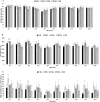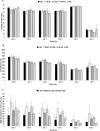In-season internal and external training load quantification of an elite European soccer team
- PMID: 31009464
- PMCID: PMC6476476
- DOI: 10.1371/journal.pone.0209393
In-season internal and external training load quantification of an elite European soccer team
Erratum in
-
Correction: In-season internal and external training load quantification of an elite European soccer team.PLoS One. 2024 May 9;19(5):e0303763. doi: 10.1371/journal.pone.0303763. eCollection 2024. PLoS One. 2024. PMID: 38723013 Free PMC article.
Abstract
Elite soccer teams that participate in European competitions need to have players in the best physical and psychological status possible to play matches. As a consequence of congestive schedule, controlling the training load (TL) and thus the level of effort and fatigue of players to reach higher performances during the matches is therefore critical. Therefore, the aim of the current study was to provide the first report of seasonal internal and external training load that included Hooper Index (HI) scores in elite soccer players during an in-season period. Nineteen elite soccer players were sampled, using global position system to collect total distance, high-speed distance (HSD) and average speed (AvS). It was also collected session rating of perceived exertion (s-RPE) and HI scores during the daily training sessions throughout the 2015-2016 in-season period. Data were analysed across ten mesocycles (M: 1 to 10) and collected according to the number of days prior to a one-match week. Total daily distance covered was higher at the start (M1 and M3) compared to the final mesocycle (M10) of the season. M1 (5589m) reached a greater distance than M5 (4473m) (ES = 9.33 [12.70, 5.95]) and M10 (4545m) (ES = 9.84 [13.39, 6.29]). M3 (5691m) reached a greater distance than M5 (ES = 9.07 [12.36, 5.78]), M7 (ES = 6.13 [8.48, 3.79]) and M10 (ES = 9.37 [12.76, 5.98]). High-speed running distance was greater in M1 (227m), than M5 (92m) (ES = 27.95 [37.68, 18.22]) and M10 (138m) (ES = 8.46 [11.55, 5.37]). Interestingly, the s-RPE response was higher in M1 (331au) in comparison to the last mesocycle (M10, 239au). HI showed minor variations across mesocycles and in days prior to the match. Every day prior to a match, all internal and external TL variables expressed significant lower values to other days prior to a match (p<0.01). In general, there were no differences between player positions. Conclusions: Our results reveal that despite the existence of some significant differences between mesocycles, there were minor changes across the in-season period for the internal and external TL variables used. Furthermore, it was observed that MD-1 presented a reduction of external TL (regardless of mesocycle) while internal TL variables did not have the same record during in-season match-day-minus.
Conflict of interest statement
The authors have declared that no competing interests exist.
Figures




Similar articles
-
In-season training load quantification of one-, two- and three-game week schedules in a top European professional soccer team.Physiol Behav. 2019 Mar 15;201:146-156. doi: 10.1016/j.physbeh.2018.11.036. Epub 2018 Dec 6. Physiol Behav. 2019. PMID: 30529511
-
Will Next Match Location Influence External and Internal Training Load of a Top-Class Elite Professional European Soccer Team?Int J Environ Res Public Health. 2021 May 14;18(10):5229. doi: 10.3390/ijerph18105229. Int J Environ Res Public Health. 2021. PMID: 34069032 Free PMC article.
-
Does the distribution of the weekly training load account for the match results of elite professional soccer players?Physiol Behav. 2020 Oct 15;225:113118. doi: 10.1016/j.physbeh.2020.113118. Epub 2020 Aug 1. Physiol Behav. 2020. PMID: 32750434
-
Training in women soccer players: A systematic review on training load monitoring.Front Psychol. 2022 Jul 29;13:943857. doi: 10.3389/fpsyg.2022.943857. eCollection 2022. Front Psychol. 2022. PMID: 35967662 Free PMC article.
-
Differences in Physical Match Performance and Injury Occurrence Before and After the COVID-19 Break in Professional European Soccer Leagues: A Systematic Review.Sports Med Open. 2022 Sep 30;8(1):121. doi: 10.1186/s40798-022-00505-z. Sports Med Open. 2022. PMID: 36178557 Free PMC article.
Cited by
-
Extended Energy-Expenditure Model in Soccer: Evaluating Player Performance in the Context of the Game.Sensors (Basel). 2022 Dec 14;22(24):9842. doi: 10.3390/s22249842. Sensors (Basel). 2022. PMID: 36560210 Free PMC article.
-
In-Season Quantification and Relationship of External and Internal Intensity, Sleep Quality, and Psychological or Physical Stressors of Semi-Professional Soccer Players.Biology (Basel). 2022 Mar 18;11(3):467. doi: 10.3390/biology11030467. Biology (Basel). 2022. PMID: 35336840 Free PMC article.
-
Modeling the Major Influencing Factor on Match Running Performance during the In-Season Phase in a Portuguese Professional Football Team.Sports (Basel). 2022 Aug 12;10(8):121. doi: 10.3390/sports10080121. Sports (Basel). 2022. PMID: 36006088 Free PMC article.
-
Training and match load ratios in professional soccer-should we use player- or position-specific match reference values?Front Sports Act Living. 2023 May 16;5:1151828. doi: 10.3389/fspor.2023.1151828. eCollection 2023. Front Sports Act Living. 2023. PMID: 37260734 Free PMC article.
-
Weekly Programming of Hamstring-Related Training Contents in European Professional Soccer.Sports (Basel). 2024 Mar 5;12(3):73. doi: 10.3390/sports12030073. Sports (Basel). 2024. PMID: 38535736 Free PMC article.
References
Publication types
MeSH terms
Grants and funding
LinkOut - more resources
Full Text Sources
Research Materials

